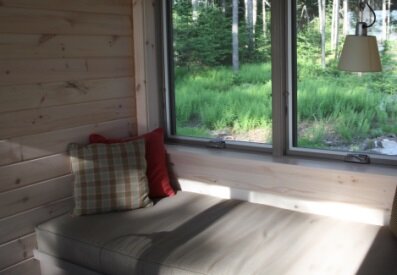Inclined to Recline
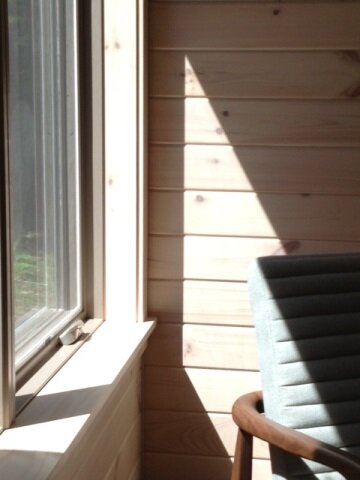
So, from the few folks to whom I’ve shown my new writer’s digs located in the woods adjacent to our house, the most animated responses have not been to the inviting expanse of built-in desktop. Small notice is given the pine-planked walls pocked with interesting knots or the green-and-blue view beyond the window above my desk. There’s little exclamation over the generosity of afternoon light pouring in. Instead, it’s the daybed tucked into a corner, a sort of boat cushion mounted on a platform that elicits the most attention.
"Oh, so that’s what this place is really for, eh? Naps!”
Or, “Huh-huh, work. Right.”
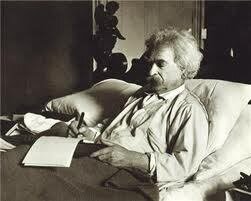
I’ve refrained from referring to several writers known to have written their masterpieces lying down, among them Mark Twain, Marcel Proust and Truman Capote, a self-declared “completely horizontal author” and very adept, he once claimed, at balancing his typewriter on his knees. I’ve yet to try to deflect daybed attention by noting an article that reported Gay Talese pinned pages of his writing to a wall and examined them through binoculars from the other side of the room – albeit without any mention of whether doing so he was supine. I haven’t divulged my preference for revising new work from a sort of recumbent position, even if I’m not as adept as Capote and my hand-written revisions when I'm reclined border on the illegible.
Nor have I conceded that the daybed may indeed invite the kind of snoozes familiar to a swaying hammock or a screened porch with comfy couch or even a cushy chair that beckons after the consumption of a heavier-than-usual lunch. But to nap in what’s purportedly a work place? Doesn’t that make me a kind of lazy cheat? But of what? And to whom? I mean, in my little domain, who’s the boss?
I confess: I nap. I love to nap. Power nap, to be more precise – those 15-20 minute wonders I often summon mid-afternoon, usually while slouched in a chair and ottoman in my house, but now easily transferrable to a daybed among the trees.
Research tells me this is good. Power naps supplement normal sleep. If no more than 30 minutes, they render you alert and re-energized upon awaking. More effective than caffeine, a power nap improves memory, cognition, creativity and energy.
Naps aren’t new, of course. They’ve been around for centuries, often known elsewhere as siestas. Typically longer, sometimes a couple of hours in duration, they have long seemed so decidedly un-American, so contrary to our – euphemism alert – work ethic. But power naps are gaining more acceptance, even in the corporate workplace, thanks to the bouts of increased productivity that, say scientists, follow a brief snooze. No doubt the name also helps – power having considerable currency in what is most decidedly American.
Neuroscientists claim that short naps help rescue us from “information overload” and provide a much-needed “mental spark.” Monitoring the brain activity of dozing nap-takers, they’ve discovered that the right side – the creativity side – of the brain is a busy chatterer during these supposed down-times. Professor Andrei Medvedev likens it to “housecleaning.” Naps help the brain perform tasks of consolidation, of transferring pieces of information from the short term memory bank to a more permanent one.
For writer William Gibson, naps are essential. They’re part of his creative process. Not for dreams, he says, but “that state adjacent to sleep, the mind on waking.” The pursuit of power naps also puts me in the august company of inventor Thomas Edison.
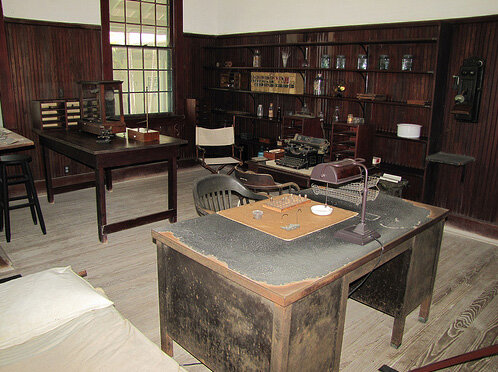
(Edison laboratory with day bed)
Okay, so I’ve never invented anything – surely not the light bulb or the phonograph. Nor did I help develop the first motion picture camera. And I certainly don’t agree with Edison who, according to a recent Brain Pickings article, regarded sleep as a waste of time, “a heritage from our cave days.” For him, the light bulb helped liberate people from the burden of sleep. Prodigious in work output and parsimonious in sleep, Edison claimed he only needed four to five hours of shut-eye per night. Anything more was a lamentable loss of “time, vitality and opportunities.”
But, claims Brain Pickings, while Edison seemed to wear his disdain for sleep like a badge of honor, he possessed a “duplicitous little secret” – napping cots. Scattered across his property in laboratories and libraries and under the trees were places where Edison could sink into instantaneous and profound sleep, and from which he woke fresh and in, he once boasted, “immediate full possession.” Edison the Power Napper.
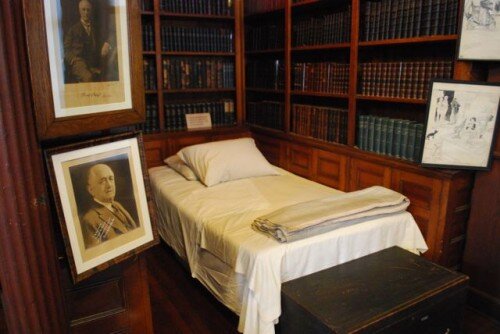
(Edison library)
Knowing that Edison napped as do numerous writers – Vita Sackville-West, for example, possessed a daybed in her writing tower – won’t prevent me from occasionally asking myself, Why nap when I could be reading, writing, taking a walk? But if I wake more refreshed and thus able to engage in such activities? And what of those nap-times when whatever has shifted in my brain’s chattering housecleaning side prompts me to tackle a different route through a difficult passage or to bridge an awkward transition in a new and surprising way?
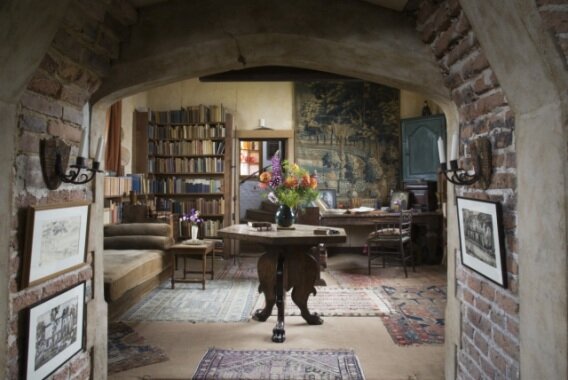
(Vita-Sackville West writing tower room)
Unlike novelist Philip Roth, I have no lectern in my new writing digs at which to stand and write. And if I did, I wouldn’t, as he does, turn it to face away from the view to avoid distraction. And if, like Talese, I had some desk-side binoculars, I’d likely not use them to review my written pages but confirm that yes, at long last, the purple finches have found the new feeder. I do have a daybed though, and the small blanket and pillow stashed beneath it is a dead give-away of my intention. And why not? “Let’s sleep on it,” we often counsel. Yes, let’s.
